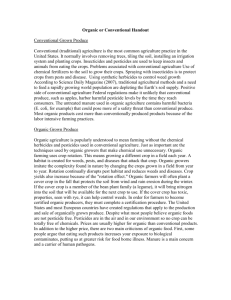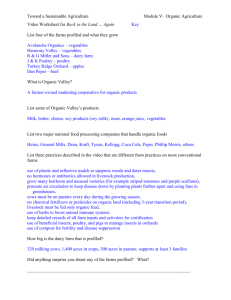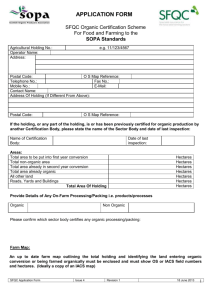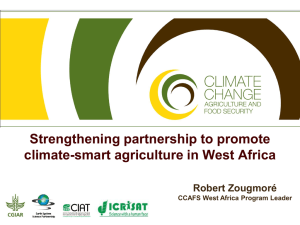Organic Conservation Stewardship Program
advertisement
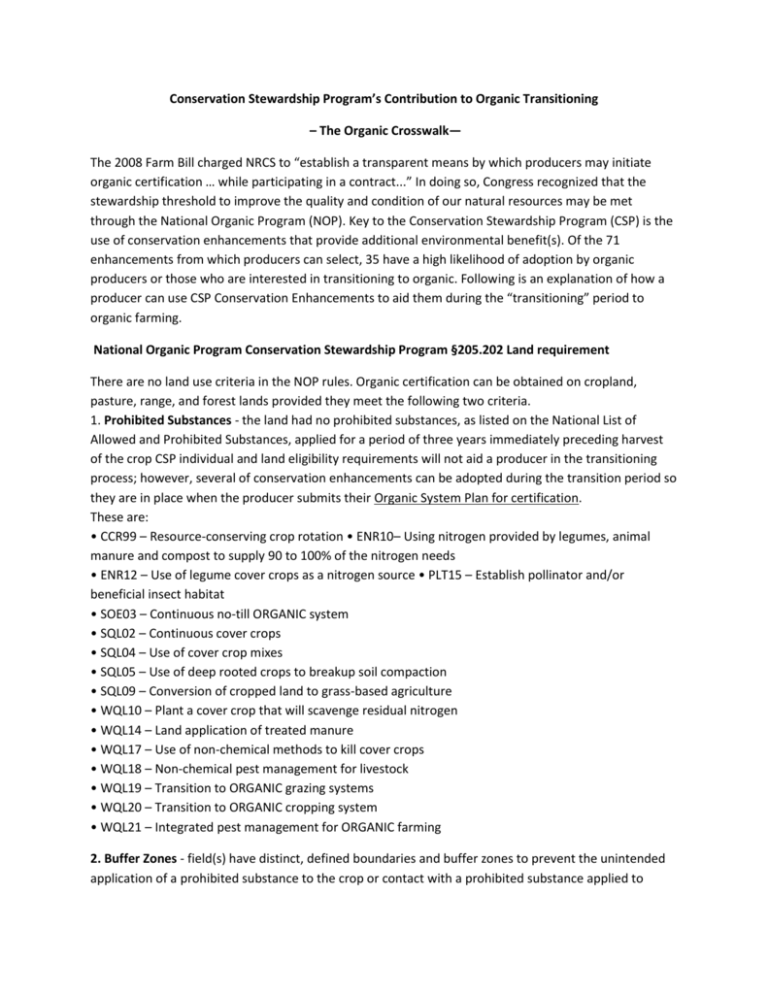
Conservation Stewardship Program’s Contribution to Organic Transitioning – The Organic Crosswalk— The 2008 Farm Bill charged NRCS to “establish a transparent means by which producers may initiate organic certification … while participating in a contract...” In doing so, Congress recognized that the stewardship threshold to improve the quality and condition of our natural resources may be met through the National Organic Program (NOP). Key to the Conservation Stewardship Program (CSP) is the use of conservation enhancements that provide additional environmental benefit(s). Of the 71 enhancements from which producers can select, 35 have a high likelihood of adoption by organic producers or those who are interested in transitioning to organic. Following is an explanation of how a producer can use CSP Conservation Enhancements to aid them during the “transitioning” period to organic farming. National Organic Program Conservation Stewardship Program §205.202 Land requirement There are no land use criteria in the NOP rules. Organic certification can be obtained on cropland, pasture, range, and forest lands provided they meet the following two criteria. 1. Prohibited Substances - the land had no prohibited substances, as listed on the National List of Allowed and Prohibited Substances, applied for a period of three years immediately preceding harvest of the crop CSP individual and land eligibility requirements will not aid a producer in the transitioning process; however, several of conservation enhancements can be adopted during the transition period so they are in place when the producer submits their Organic System Plan for certification. These are: • CCR99 – Resource-conserving crop rotation • ENR10– Using nitrogen provided by legumes, animal manure and compost to supply 90 to 100% of the nitrogen needs • ENR12 – Use of legume cover crops as a nitrogen source • PLT15 – Establish pollinator and/or beneficial insect habitat • SOE03 – Continuous no-till ORGANIC system • SQL02 – Continuous cover crops • SQL04 – Use of cover crop mixes • SQL05 – Use of deep rooted crops to breakup soil compaction • SQL09 – Conversion of cropped land to grass-based agriculture • WQL10 – Plant a cover crop that will scavenge residual nitrogen • WQL14 – Land application of treated manure • WQL17 – Use of non-chemical methods to kill cover crops • WQL18 – Non-chemical pest management for livestock • WQL19 – Transition to ORGANIC grazing systems • WQL20 – Transition to ORGANIC cropping system • WQL21 – Integrated pest management for ORGANIC farming 2. Buffer Zones - field(s) have distinct, defined boundaries and buffer zones to prevent the unintended application of a prohibited substance to the crop or contact with a prohibited substance applied to adjoining land that is not under organic management NOP rules require that buffer zones be established to protect organic fields from contamination from off farm activities. CSP buffer enhancement practices can be used to improve existing buffers to conform to what the certifying agent requires, improve vegetation for beneficial insects and pollinators, and/or manage buffers for wildlife purposes. CSP buffer enhancements can be implemented to be established when the transition period is completed. CSP enhancements that benefit buffer zones include: • ANM05 – Extending riparian forest buffers for water quality protection and wildlife habitat • ANM07 – Extending existing field borders for water quality protection and wildlife habitat • ANM32 – Extend existing filter strips and riparian herbaceous cover for water quality protection and wildlife habitat • ANM33 – Riparian buffer, terrestrial and aquatic wildlife habitat • PLT15 – Establish pollinator and/or beneficial insect habitat • PLT18 – Increasing on-farm food production with edible woody buffer landscapes §205.203 Soil fertility and crop nutrient management practice standard Key to organic farming principles is growing crops without the use of synthetic fertilizer. NOP rules provide the criteria that must be followed in order to be considered as “Certified Organic.” These criteria are: • Use tillage and cultivation practices that maintain or improve soil quality and minimize soil erosion • Manage crop nutrients and soil fertility through rotations, cover crops, and application of plant and animal materials • Manage plant and animal materials to improve soil quality using: o raw animal manures that are incorporated into the soil prior to harvest of crops; Organic production relies on the producer's ability to manage the crop production system in a manner that builds soil fertility, while providing crop nutrients without the use of synthetic fertilizers. This is accomplished by adopting practices that improve soil quality (increasing organic matter and soil biological activity), control erosion, and cycle nutrients. The CSP offers several enhancements that will allow an organic producer or someone transitioning to organic to improve the current production system and associated environmental benefits. Soil quality improvement enhancements can help a producer meet NOP rules 205.203 a & b. The following enhancements affect all CSP resource concerns in a positive manner, but have the most significant impact on soil quality. • CCR99 – Resource-conserving crop rotation • SOE03 – Continuous no-till ORGANIC system • SQL02 – Continuous cover crops • SQL04 – Use of cover crop mixes • SQL05 – Use of deep rooted crops to breakup soil compaction §205.204 Seeds and planting stock practice standard NOP rules require that producers use organically grown seeds, seedlings, and planting stock in their productions system. Documentation as to the source of planted materials is required in the Organic System Plan. The producer must use organically grown seeds, annual seedlings, and planting stock. While the CSP has no specific requirements to use organically grown seeds, seedlings and/or plant stock, it does not prohibit their use in enhancements that require the establishment of vegetative cover or planting of trees and/or shrubs. Criteria for buffer enhancements include the use of grasses and/or forbs that are best suited for wildlife and site conditions, and they encourage use of native plant species. This is true for the selection of plants used for establishing habitat for beneficial species and pollinators. Enhancements that encourage use of native plants include: • ANM05 – Extending riparian forest buffers for water quality protection and wildlife habitat • ANM07 – Extending existing field borders for water quality protection and wildlife habitat • ANM32 – Extend existing filter strips for riparian herbaceous cover for WQ and wildlife habitat • ANM33 – Riparian buffer, terrestrial and aquatic wildlife habitat • PLT15 – Establish pollinator and/or beneficial insect habitat • PLT18 – Increasing on-farm food production with edible woody buffer landscapes §205.205 Crop rotation practice standard NOP rules require a crop rotation be followed and documented in the Organic System Plan. A crop rotation includes but is not limited to sod, cover crops, green manure crops, and catch crops that provide the following functions that are applicable to the operation: • maintain or improve soil organic matter content; • provide for pest management in annual and perennial crops; • manage deficient or excess plant nutrients; and • provide erosion control A conservation crop rotation plays a pivotal role in developing a conservation plan. It can help mitigate the negative effects of tillage, increase soil organic matter, provide nutrients and control erosion, all criteria that the NOP rules require of the crop rotation. CSP evaluates the crop rotation in the resource inventory process. CSP offers enhancements that will encourage a higher environmental benefit and that can be implemented during the organic transitioning period. These enhancements are: • CCR99 – Resource-conserving crop rotation • ENR12 – Use of legume cover crops as a nitrogen source • SOE03 – Continuous no-till ORGANIC system • SQL02 – Continuous cover crops • SQL04 – Use of cover crop mixes • SQL05 – Use of deep rooted crops to break up soil compaction • WQL10 – Plant a cover crop that will scavenge residual nitrogen • WQL17 – Use of non-chemical methods to kill cover crops • WQL20 – Transition to ORGANIC cropping system • WQL21 – Integrated pest management for ORGANIC farming §205.206 Crop pest, weed, and disease management practice standard NOP rules require producers to use management practices to prevent crop pests, weeds, and diseases. Practices include: • crop rotation and soil and nutrient management practices • sanitation measures • cultural practices that enhance crop health, including using resistant varieties Pests may be controlled using mechanical or physical methods, including: • mulching using biodegradable materials • mowing • livestock grazing • hand weeding and mechanical cultivation Managing pests on an organic farm relies primarily on ecologically based cultural and biological practices. The NOP pest, weed, and disease management practices all align with the Integrated Pest Management components of prevention, avoidance, monitoring, and suppression that are the foundation of NRCS pest management policy. CSP evaluates existing pest management activities in the resource inventory process. CSP offers enhancements that encourage producers to achieve a higher environmental benefit and that can be implemented during the transition period. These enhancements are: • CCR99 – Resource-conserving crop rotation • PLT15 – Establish pollinator and/or beneficial insect habitat • SOE03 – Continuous no-till ORGANIC system • SQL02 – Continuous cover crops • SQL04 – Use of cover crop mixes • WQL17 – Use of non-chemical methods to kill cover crops • WQL20 – Transition to ORGANIC cropping system • WQL21 – Integrated pest management for ORGANIC farming §205.207 Wild-crop harvesting practice standard The NOP allows for the harvest of “Wild Crops” that are collected or harvested from a site that is not maintained under cultivation or other agricultural management, which includes forested acres. NOP practice requirements: • A wild crop that is intended to be sold, labeled, or represented as organic must be harvested from a designated area that has had no prohibited substance, as set forth in §205.105, applied to it for a period of three years immediately preceding the harvest of the wild crop. • A wild crop must be harvested in a manner that ensures that such harvesting or gathering will not be destructive to the environment and will sustain the growth and production of the wild crop. CSP has added non-industrial private forest as an eligible land use. Manipulation of the forest species composition, structure, and canopy cover to achieve a desired native plant community that facilitates the sustainable management of native non-timber forest plants is supported with a CSP enhancement. These plants can include species that are considered “wild crops” by the NOP rule. Management activities include pruning, selective thinning, and the introduction of new species, all of which are allowable under the NOP rules. These activities can be implemented during the transition period. These enhancements include: • PLT05 – Multi-story cropping, sustainable management of non-timber forest plants • PLT18 – Increasing on-farm food production with edible woody buffer landscapes §205.236 Origin of livestock NOP rules require that livestock products that are to be sold, labeled, or represented as organic must be from livestock under continuous organic management from the last third of gestation or hatching The Conservation Stewardship Program rules exclude developed areas from the farm such as farm headquarters, ranch sites, barnyards, feedlots, manure storage facilities, machinery storage areas, and material handling facilities from being eligible for program participation. The rules also have no provisions related to livestock origin, breeding, hatching, or rearing except as to how these activities might impact eligible lands. §205.237 Livestock feed NOP rules require the producer of an organic livestock operation to provide livestock with a total feed ration composed of agricultural products, including pasture and forage, which are organically produced. The Conservation Stewardship Program encourages the management of forage, hay and other livestock feed to improve plant health, diversity, and forage quality. CSP measures the environmental impacts of a grazing system through the Conservation Measurement Tool (CMT). CSP offers enhancements that encourage producers to achieve a higher environmental benefit and that can be implemented during the transition period. These enhancements are: • ANM03 – Incorporate native grasses and/or legumes into 15% or more of the herbage dry matter productivity • ANM25– Stockpiling of forages to extend the grazing season • ANM29– On-farm forage based grazing system • PLT02 – Monitor key grazing areas to improve grazing management • PLT16 – Intensive rotational grazing • WQL19 – Transition to ORGANIC grazing systems • SQL09 – Conversion of cropped land to grass-based agriculture §205.238 Livestock health care practice standard NOP rules require the producer to establish and maintain preventive livestock health care practices, including: • selection of species and types of livestock with regard to suitability for site-specific conditions and resistance to prevalent diseases and parasites • provision of a feed ration sufficient to meet nutritional requirements, including vitamins, minerals, protein and/or amino acids, fatty acids, energy sources, and fiber (ruminants) • establishment of appropriate housing, pasture conditions, and sanitation practices to minimize the occurrence and spread of diseases and parasites • provision of conditions that allow for exercise, freedom of movement, and reduction of stress appropriate to the species • performance of physical alterations as needed to promote the animal's welfare and in a manner that minimizes pain and stress The Conservation Stewardship Program does not identify livestock health care as one of the eight primary resource concerns. However many of the program's conservation activities can provide secondary benefits for livestock health. Practices like rotational grazing encourage pasture rest periods that can help with some parasites, allow free movement of livestock, and improve pasture forage quality. Monitoring of key grazing areas or using tools to evaluate the nutritional status of livestock can be used to determine herd health. CSP enhancements that provide livestock health as a secondary benefit include: • ANM17 – Monitoring nutritional status of livestock using the NUTBAL PRO System • ANM26 – Managing calving to coincide with forage availability • ANM29– On-farm forage based grazing system • PLT02 – Monitor key grazing areas to improve grazing management • WQL03 – Rotation of supplement and feeding areas • WQL18 – Non-chemical pest management for livestock §205.239 Livestock living conditions NOP rules require the producer of an organic livestock operation to establish and maintain livestock living conditions that accommodate the health and natural behavior of animals, including: • access to the outdoors, shade, shelter, exercise areas, fresh air, and direct sunlight suitable to the species, its stage of production, the climate, and the environment; • access to pasture for ruminants; • appropriate clean, dry bedding; if the bedding is typically consumed by the animal species, it must comply with the feed requirements of §205.237; • shelter designed to allow for: o natural maintenance, comfort behaviors, and opportunity to exercise o temperature level, ventilation, and air circulation suitable to the species o reduction of potential for livestock injury CSP rules exclude developed areas from the farm, such as farm headquarters, ranch sites, barnyards, feedlots, manure storage facilities, machinery storage areas, and material handling facilities from being eligible for program participation. The program's focus is on natural resource concerns related to working farmland, e.g. cropland, pasture, range, and forest. Managing livestock access to water, using rotational grazing, planting desirable plant species, and monitoring pasture conditions all contribute to a productive grazing system and improve the living conditions of the livestock. CSP measures the environmental impacts of a grazing system through the Conservation Measurement Tool (CMT). CSP offers enhancements that encourage producers to achieve a higher environmental benefit and that can be implemented during the transition period. Enhancements to improve grazing systems are: • ANM03 – Incorporate native grasses and/or legumes into 15% or more of the herbage dry matter productivity • ANM17 – Monitoring nutritional status of livestock using the NUTBAL PRO System • ANM26 – Managing calving to coincide with forage availability • ANM29– On-farm forage based grazing system • PLT02 – Monitor key grazing areas to improve grazing management • PLT16 – Intensive rotational grazing • SQL09 – Conversion of cropped land to grass based agriculture • WQL19 – Transition to ORGANIC grazing systems § 205.240 Pasture practice standard NOP rules require the producer of an organic livestock operation to demonstrate through there organic system plan a functioning plan for pasture that: • Annually provides a minimum of 30% of a ruminant’s dry matter intake over the course of the grazing season; • Plan must included: o Type of pasture o Cultural and management practices used to ensure pasture of sufficient quality and quantity is available throughout the grazing season o Types of grazing methods used o Location and type of fences used o Soil fertility and seeding systems o Erosion control and protection of natural wetlands and riparian areas. The Conservation Stewardship Program encourages the management of forage, hay and other livestock feed to improve plant health, diversity, and forage quality. CSP measures the environmental impacts of a grazing system through the Conservation Measurement Tool (CMT). CSP offers enhancements that encourage producers to achieve a higher environmental benefit and that can be implemented during the transition period. These enhancements are: • ANM03 – Incorporate native grasses and/or legumes into 15% or more of the herbage dry matter productivity • ANM17 – Monitoring nutritional status of livestock using the NUTBAL PRO System • ANM25– Stockpiling of forages to extend the grazing season • ANM26 - Managing calving to coincide with forage availability • ANM29– On-farm forage based grazing system • PLT02 – Monitor key grazing areas to improve grazing management • PLT16 – Intensive rotational grazing • SQL09 - Conversion of cropped land to grass-base agriculture • WQL03 – Rotation of supplement and feeding areas • WQL18 - Non-chemical pest management for livestock • WQL19 – Transition to ORGANIC grazing systems

